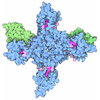+ Open data
Open data
- Basic information
Basic information
| Entry | Database: PDB / ID: 9dwq | |||||||||||||||||||||||||||
|---|---|---|---|---|---|---|---|---|---|---|---|---|---|---|---|---|---|---|---|---|---|---|---|---|---|---|---|---|
| Title | PKD2 ion channel, F629S variant | |||||||||||||||||||||||||||
 Components Components | Polycystin-2 | |||||||||||||||||||||||||||
 Keywords Keywords | MEMBRANE PROTEIN / Ion channel / TRP channel / polycystin | |||||||||||||||||||||||||||
| Function / homology |  Function and homology information Function and homology informationdetection of nodal flow / metanephric smooth muscle tissue development / metanephric cortex development / metanephric cortical collecting duct development / metanephric distal tubule development / polycystin complex / mesonephric tubule development / mesonephric duct development / metanephric part of ureteric bud development / renal tubule morphogenesis ...detection of nodal flow / metanephric smooth muscle tissue development / metanephric cortex development / metanephric cortical collecting duct development / metanephric distal tubule development / polycystin complex / mesonephric tubule development / mesonephric duct development / metanephric part of ureteric bud development / renal tubule morphogenesis / determination of liver left/right asymmetry / metanephric ascending thin limb development / metanephric mesenchyme development / metanephric S-shaped body morphogenesis / basal cortex / renal artery morphogenesis / HLH domain binding / calcium-induced calcium release activity / cilium organization / migrasome / VxPx cargo-targeting to cilium / detection of mechanical stimulus / muscle alpha-actinin binding / regulation of calcium ion import / voltage-gated monoatomic ion channel activity / placenta blood vessel development / cellular response to hydrostatic pressure / cellular response to fluid shear stress / cation channel complex / outward rectifier potassium channel activity / non-motile cilium / actinin binding / cellular response to osmotic stress / determination of left/right symmetry / : / voltage-gated monoatomic cation channel activity / neural tube development / voltage-gated sodium channel activity / aorta development / motile cilium / ciliary membrane / branching involved in ureteric bud morphogenesis / protein heterotetramerization / negative regulation of G1/S transition of mitotic cell cycle / spinal cord development / heart looping / positive regulation of phospholipase C-activating G protein-coupled receptor signaling pathway / cytoplasmic side of endoplasmic reticulum membrane / centrosome duplication / voltage-gated potassium channel activity / cell surface receptor signaling pathway via JAK-STAT / potassium channel activity / embryonic placenta development / monoatomic cation channel activity / voltage-gated calcium channel activity / transcription regulator inhibitor activity / cytoskeletal protein binding / release of sequestered calcium ion into cytosol / potassium ion transmembrane transport / sodium ion transmembrane transport / cellular response to calcium ion / basal plasma membrane / cytoplasmic vesicle membrane / cellular response to cAMP / cellular response to reactive oxygen species / lumenal side of endoplasmic reticulum membrane / protein tetramerization / phosphoprotein binding / establishment of localization in cell / liver development / calcium ion transmembrane transport / Wnt signaling pathway / intracellular calcium ion homeostasis / positive regulation of nitric oxide biosynthetic process / mitotic spindle / cell-cell junction / calcium ion transport / lamellipodium / regulation of cell population proliferation / heart development / ATPase binding / protein homotetramerization / basolateral plasma membrane / transmembrane transporter binding / cell surface receptor signaling pathway / regulation of cell cycle / cilium / ciliary basal body / signaling receptor binding / negative regulation of cell population proliferation / calcium ion binding / positive regulation of gene expression / endoplasmic reticulum membrane / endoplasmic reticulum / Golgi apparatus / protein homodimerization activity / positive regulation of transcription by RNA polymerase II / extracellular exosome / identical protein binding / membrane Similarity search - Function | |||||||||||||||||||||||||||
| Biological species |  Homo sapiens (human) Homo sapiens (human) | |||||||||||||||||||||||||||
| Method | ELECTRON MICROSCOPY / single particle reconstruction / cryo EM / Resolution: 2.76 Å | |||||||||||||||||||||||||||
 Authors Authors | Esarte Palomero, O. / DeCaen, P.G. | |||||||||||||||||||||||||||
| Funding support |  United States, 5items United States, 5items
| |||||||||||||||||||||||||||
 Citation Citation |  Journal: Proc Natl Acad Sci U S A / Year: 2025 Journal: Proc Natl Acad Sci U S A / Year: 2025Title: Pathogenic variants in the polycystin pore helix cause distinct forms of channel dysfunction. Authors: Orhi Esarte Palomero / Eduardo Guadarrama / Paul G DeCaen /  Abstract: PKD2 is a member of the polycystin subfamily of transient receptor potential (TRP) ion channel subunits which traffic and function in primary cilia organelle membranes. Millions of individuals carry ...PKD2 is a member of the polycystin subfamily of transient receptor potential (TRP) ion channel subunits which traffic and function in primary cilia organelle membranes. Millions of individuals carry pathogenic genetic variants in PKD2 that cause a life-threatening condition called autosomal dominant polycystic kidney disease (ADPKD). Although ADPKD is a common monogenetic disorder, there is no drug cure or available therapeutics which address the underlying channel dysregulation. Furthermore, the structural and mechanistic impacts of most disease-causing variants are uncharacterized. Using direct cilia electrophysiology, cryogenic electron microscopy (cryo-EM), and superresolution imaging, we have found mechanistic differences in channel dysregulation caused by three germline missense variants located in PKD2's pore helix 1. Variant C632R reduces protein thermal stability, resulting in impaired channel assembly and abolishes primary cilia trafficking. In contrast, variants F629S and R638C retain native cilia trafficking but exhibit gating defects. Cryo-EM structures (2.7 to 2.8 Å resolution) indicate loss of critical pore helix interactions which precipitate allosteric collapse of the channels inner gate. Results demonstrate how ADPKD-causing mutations cause mechanistically divergent and ranging impacts on PKD2 function, despite their shared structural proximity. These unexpected findings highlight the need for structural and biophysical characterization of polycystin variants, which will guide rational drug development of ADPKD therapeutics. | |||||||||||||||||||||||||||
| History |
|
- Structure visualization
Structure visualization
| Structure viewer | Molecule:  Molmil Molmil Jmol/JSmol Jmol/JSmol |
|---|
- Downloads & links
Downloads & links
- Download
Download
| PDBx/mmCIF format |  9dwq.cif.gz 9dwq.cif.gz | 727.7 KB | Display |  PDBx/mmCIF format PDBx/mmCIF format |
|---|---|---|---|---|
| PDB format |  pdb9dwq.ent.gz pdb9dwq.ent.gz | 606.5 KB | Display |  PDB format PDB format |
| PDBx/mmJSON format |  9dwq.json.gz 9dwq.json.gz | Tree view |  PDBx/mmJSON format PDBx/mmJSON format | |
| Others |  Other downloads Other downloads |
-Validation report
| Summary document |  9dwq_validation.pdf.gz 9dwq_validation.pdf.gz | 1.6 MB | Display |  wwPDB validaton report wwPDB validaton report |
|---|---|---|---|---|
| Full document |  9dwq_full_validation.pdf.gz 9dwq_full_validation.pdf.gz | 1.6 MB | Display | |
| Data in XML |  9dwq_validation.xml.gz 9dwq_validation.xml.gz | 63 KB | Display | |
| Data in CIF |  9dwq_validation.cif.gz 9dwq_validation.cif.gz | 95.5 KB | Display | |
| Arichive directory |  https://data.pdbj.org/pub/pdb/validation_reports/dw/9dwq https://data.pdbj.org/pub/pdb/validation_reports/dw/9dwq ftp://data.pdbj.org/pub/pdb/validation_reports/dw/9dwq ftp://data.pdbj.org/pub/pdb/validation_reports/dw/9dwq | HTTPS FTP |
-Related structure data
| Related structure data |  47260MC  9dliC M: map data used to model this data C: citing same article ( |
|---|---|
| Similar structure data | Similarity search - Function & homology  F&H Search F&H Search |
- Links
Links
- Assembly
Assembly
| Deposited unit | 
|
|---|---|
| 1 |
|
- Components
Components
| #1: Protein | Mass: 85043.344 Da / Num. of mol.: 4 / Mutation: F629S Source method: isolated from a genetically manipulated source Details: PKD2 variant F629S (residues 52-793) was expressed with an N-terminal StrepII-MBP-TEV cleaved prior to macromolecular analysis Source: (gene. exp.)  Homo sapiens (human) / Gene: PKD2, TRPP2 / Plasmid: pCMV / Cell line (production host): expi293 / Production host: Homo sapiens (human) / Gene: PKD2, TRPP2 / Plasmid: pCMV / Cell line (production host): expi293 / Production host:  Homo sapiens (human) / References: UniProt: Q13563 Homo sapiens (human) / References: UniProt: Q13563#2: Chemical | ChemComp-CA / | Has ligand of interest | Y | Has protein modification | Y | |
|---|
-Experimental details
-Experiment
| Experiment | Method: ELECTRON MICROSCOPY |
|---|---|
| EM experiment | Aggregation state: PARTICLE / 3D reconstruction method: single particle reconstruction |
- Sample preparation
Sample preparation
| Component | Name: PKD2 ion channel F629S variant protomer / Type: COMPLEX / Entity ID: #1 / Source: RECOMBINANT | |||||||||||||||||||||||||
|---|---|---|---|---|---|---|---|---|---|---|---|---|---|---|---|---|---|---|---|---|---|---|---|---|---|---|
| Molecular weight | Value: 0.3396 MDa / Experimental value: NO | |||||||||||||||||||||||||
| Source (natural) | Organism:  Homo sapiens (human) Homo sapiens (human) | |||||||||||||||||||||||||
| Source (recombinant) | Organism:  Homo sapiens (human) / Strain: HEK293 / Cell: expi293 / Plasmid: pCMV Homo sapiens (human) / Strain: HEK293 / Cell: expi293 / Plasmid: pCMV | |||||||||||||||||||||||||
| Buffer solution | pH: 7.4 Details: 25 mM HEPES-NaOH, 150 mM NaCl, 1 mM CaCl2, 1 mM TCEP | |||||||||||||||||||||||||
| Buffer component |
| |||||||||||||||||||||||||
| Specimen | Conc.: 1 mg/ml / Embedding applied: NO / Shadowing applied: NO / Staining applied: NO / Vitrification applied: YES Details: Stabilized in amphipol A8-35. Monodisperse sample after gel filtration in a Superdex 200 column. | |||||||||||||||||||||||||
| Specimen support | Details: 15 mA / Grid material: COPPER / Grid mesh size: 300 divisions/in. / Grid type: Quantifoil R2/1 | |||||||||||||||||||||||||
| Vitrification | Instrument: LEICA EM GP / Cryogen name: ETHANE / Humidity: 95 % / Chamber temperature: 278 K Details: Vitrification carried in air. Ethane temperature -183 C |
- Electron microscopy imaging
Electron microscopy imaging
| Experimental equipment |  Model: Titan Krios / Image courtesy: FEI Company |
|---|---|
| Microscopy | Model: TFS KRIOS |
| Electron gun | Electron source:  FIELD EMISSION GUN / Accelerating voltage: 300 kV / Illumination mode: FLOOD BEAM FIELD EMISSION GUN / Accelerating voltage: 300 kV / Illumination mode: FLOOD BEAM |
| Electron lens | Mode: BRIGHT FIELD / Nominal magnification: 130000 X / Nominal defocus max: 2400 nm / Nominal defocus min: 600 nm / Cs: 2.7 mm / Alignment procedure: BASIC |
| Specimen holder | Cryogen: NITROGEN / Specimen holder model: FEI TITAN KRIOS AUTOGRID HOLDER |
| Image recording | Electron dose: 60 e/Å2 / Film or detector model: GATAN K3 (6k x 4k) / Num. of grids imaged: 1 / Num. of real images: 9145 / Details: 50 frame movie stacks. Super-resolution mode |
| EM imaging optics | Energyfilter name: GIF Bioquantum / Energyfilter slit width: 10 eV |
| Image scans | Width: 11520 / Height: 8184 |
- Processing
Processing
| EM software |
| ||||||||||||||||||||||||||||||||||||||||||||||||
|---|---|---|---|---|---|---|---|---|---|---|---|---|---|---|---|---|---|---|---|---|---|---|---|---|---|---|---|---|---|---|---|---|---|---|---|---|---|---|---|---|---|---|---|---|---|---|---|---|---|
| CTF correction | Type: PHASE FLIPPING AND AMPLITUDE CORRECTION | ||||||||||||||||||||||||||||||||||||||||||||||||
| Particle selection | Num. of particles selected: 1046126 Details: Denoised micrographs were blob picked (130-170 angstrom) | ||||||||||||||||||||||||||||||||||||||||||||||||
| Symmetry | Point symmetry: C4 (4 fold cyclic) | ||||||||||||||||||||||||||||||||||||||||||||||||
| 3D reconstruction | Resolution: 2.76 Å / Resolution method: FSC 0.143 CUT-OFF / Num. of particles: 215875 / Algorithm: FOURIER SPACE Details: Final reconstruction performed with C4 symmetry imposed Num. of class averages: 1 / Symmetry type: POINT | ||||||||||||||||||||||||||||||||||||||||||||||||
| Atomic model building | B value: 107.9 / Space: REAL Details: The initial Alphafold model was fitted to the map using ChimeraX. Refinement was performed using ISOLDE and PHENIX. | ||||||||||||||||||||||||||||||||||||||||||||||||
| Atomic model building | Source name: AlphaFold / Type: in silico model | ||||||||||||||||||||||||||||||||||||||||||||||||
| Refine LS restraints |
|
 Movie
Movie Controller
Controller




 PDBj
PDBj


